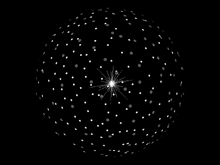
A Diagram of a Common Dyson Swarm
A Dyson swarm (not to be confused with a Dyson Sphere) is a general term to describe a collection of constructs around a star used to gather its energy. The first one known to humanity was built around Sol in 2245. The concept dates all the way back to the 20th century. This technology is named after Freeman Dyson
Design[]
A Dyson swarm is similar to a Dyson Sphere, with one major difference. A Dyson swarm is a collection of satellites used to harvest a significant percentage of a star's energy output. A structure like this could gather anywhere from 0.01% of s stars output to almost 100%.
Once the satellites are in place, they transmit the energy gathered via wireless power transfer to planets or other bodies.
Variations[]
Like with any Mega Structure, there are hundreds of variations. Each civilization has a slightly different take on the design. Civilizations that make it to Type II status usually have one dyson swarm, which marks the beginning of their new form of energy-harvesting.
Dyson Ring[]

A typical Dyson Ring
A Dyson Ring is a primitive version of a Dyson Swarm. This structure is typically the first Mega Structure built by Type I civilizations. Even civilizations that are pre-Type 1 could construct a structure like this.
Humans first built a structure like this in 2104.
This structure is the most common type of Stellar Ruin in the universe. Hundreds of degraded and abandoned Dyson rings exist in the Via Lactea alone, suggesting hundreds of extinct type I civilizations. They degrade relatively quickly, but remain detectable for millions of years.
Multiple rings can be arranged to orbit a star, but by the time a civilization could do this, a Dyson Bubble would be far more effective.

A Dyson Bubble
Dyson Bubble[]
A Dyson Bubble is a variant of Dyson Swarm that utilizes Statites—a satellite held up by the radiation pressure of a star, counteracting it's gravitational pull. Statites are completely stationary, allowing for multiple layers to be built.
This is the preferred variation for most Swarms, as many Type II civilization have been observed to build something similar to this. The technology for Statites was invented in 2278, allowing for humanity to build a Dyson bubble around the sun.
Construction[]
As with most Mega Structures, it takes large amounts of automation to create economically. Humanity's construction of a Swarm is a very typically example.
Timeline[]
2201 CE: Humanity Lands a series of probes on Mercury. These probes begin to set up large solar panels and harvest Mercury.
2202 CE: The probes begin to self replicate. The first panel for the Dyson Swarm was launched.
2217 CE: A Dyson Ring is complete.
2225 CE: Earth, Venus, Mercury, and Mars all begin to draw power from the Swarm.
2234 CE: The majority of Mercury's surface is covered in facilities to create more panels.
2245 CE: All usable metal has been harvested and converted into solar panels. Before the probes start cannibalizing each other, they are all deactivated and re-purposed. Mercury has lost over Fifty percent of its mass., and is essentially useless.
2247 CE: The Swarm is fully operational. Ten percent of the sun's energy is being utilized by humanity. Terraforming becomes much easier. The Swarm is categorized as a Dyson Bubble.
The process is very fast for advanced civilizations. Currently, it takes one month to create a Dyson Swarm.
